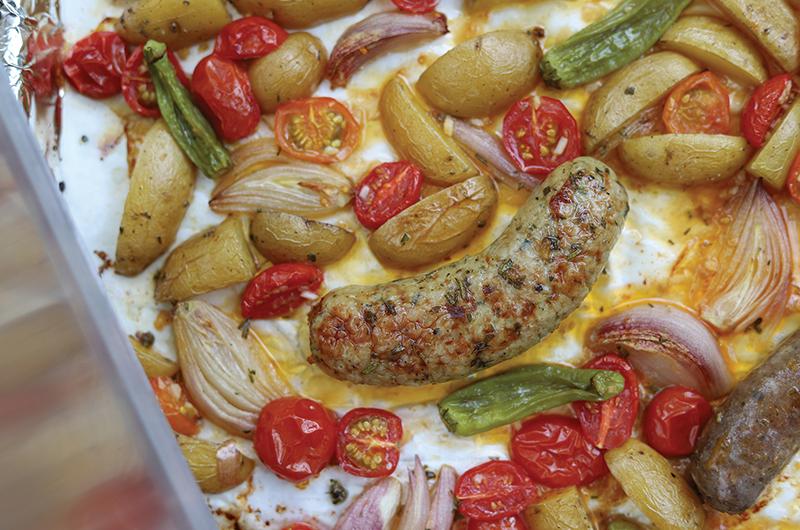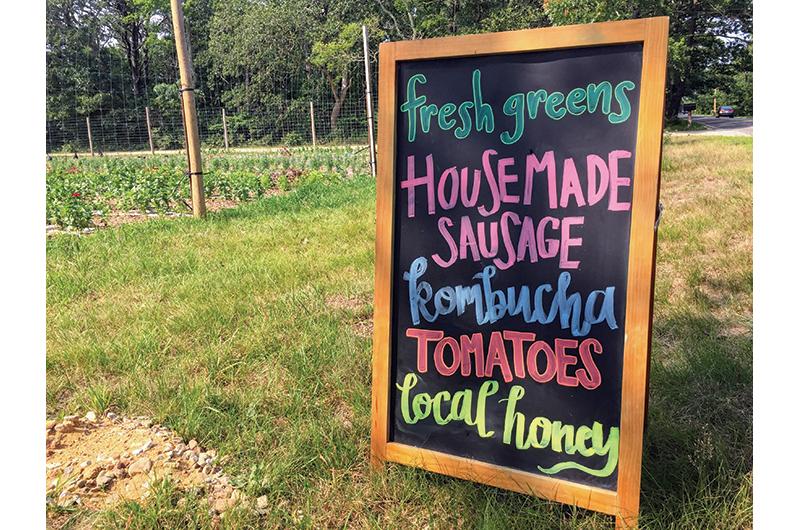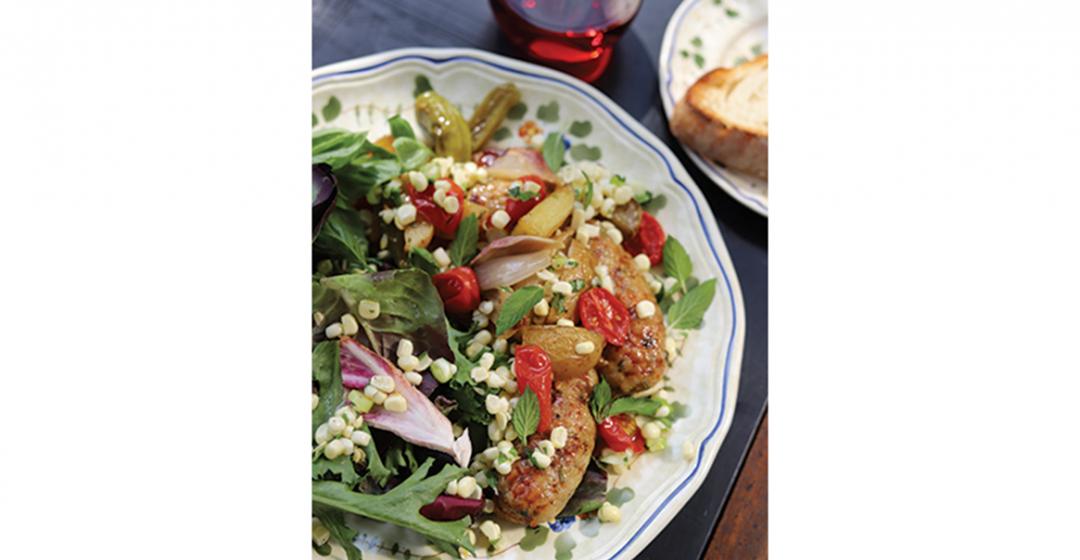This time of year, there’s no better place to eat than Martha’s Vineyard, in your own home, cooking what you’ve scooped up at Island farm stands. I take it as a personal challenge to try to make as many “all-local” meals as I can while all the good stuff is around – and coming out of my own garden. The cherry tomatoes are firing off my tomato plants like gum balls from a gum ball machine. All of a sudden the bell peppers are turning from a glossy, grassy green to a rosy sunset hue. And with our long, warm falls, Morning Glory Farm in Edgartown is still harvesting corn by the truckload, right up until the first frost at the end of October (sometimes early November!) Our choice of salad greens from farms just gets more and more amazing – this fall Chilmark’s Beetlebung Farm is trying out twelve different varieties of radicchio.
Sure, the veggie part of an all-local meal is easy, you say. But what about the protein (of the non-veggie sort)? While you could make an argument for fish every night, that might not be practical. Your next challenge is to get friendly with local meat options. This requires a bit of planning – and stocking up of the freezer, since most local meat is frozen after butchering, much of it as medium or large cuts.
Since I am always scrambling for time, I tend not to be the best on planning that far in advance. And sometimes my wallet cannot afford a huge outlay either. The solution at our house? Local sausage.
All the farms that raise livestock – Allen Farm, The Grey Barn and Farm, and Mermaid Farm, all in Chilmark, as well as Morning Glory Farm – sell their own sausage, while other local chefs and farmers, including Jefferson Munroe of the GOOD Farm and The Larder in Vineyard Haven, make sausage from local meat. Ghost Island Farm sells sausage made from Nip ’n’ Tuck Farm’s animals. (Ghost Island’s farm store is located on Nip ’n’ Tuck Farm on State Road in West Tisbury.) Availability, just like other local meat, varies, so it’s a good idea to touch base regularly with a farm stand (or stands) near you.

That’s why I’m excited that the old Whippoorwill Farm stand has been resurrected by Rose Willette, owner and operator of North Tisbury Farm & Market in West Tisbury, who now leases the Whippoorwill land from Andrew Woodruff. The little farm stand on Old County Road in West Tisbury serves as an outpost for the bigger market on State Road. Willette is revitalizing the Whippoorwill fields as well as the hoop houses, as you’ll see when you stop at the stand. So as time goes on, you’ll find goodies, from flowers and herbs to tomatoes and squash, at the open-air honor stand that have traveled mere feet to get there.
Best of all, the stand has a freezer stuffed with local sausage (and sometimes other charcuterie such as pâté de campagne). I particularly like the chicken garlic sausage, but there are different types, including sweet Italian, lamb merguez, and breakfast sausage, available at different times. Turns out the sausages are being made by Tyler Potter of The Swimming Pig, who has been popping up on my Instagram feed all summer. (Find him @theswimmingpigmv.) To grow his nascent charcuterie business, Potter has been making sausages for commercial clients, including Seaweed’s restaurant, El Gato Grande food truck, and the Orange Peel Bakery. But much of his charcuterie right now is sold through North Tisbury Farm & Market (and at the satellite Whippoorwill stand). From Allen Farm lamb shoulder to Grey Barn fatback to pork from Jo Douglas’s Fork to Pork Island-raised and Island-food-waste-fed pigs, local meat is finding a home in Potter’s sausages. It’s a very happy and tasty circle.
The Whippoorwill farm stand is a convenient stop for me, but when I’m at other farm stands I still keep an eye out for sausage. Sausages defrost quickly – overnight in the fridge is best, but in a pinch you can put the Cryovaced package in a bowl of cold (not warm) water in the sink for no more than two hours (and less if your room temp is very warm). Or bring them home and return them to the freezer – they don’t take up much room.
When it comes to cooking local sausage, I have a few pieces of advice for you. First, try to manage your expectations of finding one particular type of sausage. While most of the farms make an Italian-style pork sausage, the individual products vary a lot, and you may find that the Italian sausages have sold out and that you have to choose from another pork sausage (for instance, an Andouille, which won’t necessarily match a commercial Andouille sausage in style), a lamb-based sausage, or even a beef product. Local sausages often do not have as much fat or filler as commercial sausages either, so they can be leaner and might cook more quickly than something you’re used to buying at the grocery store.
To that end, I try to stay flexible and use flavors and techniques that would work with any fresh sausage. Have you ever met a sausage that didn’t like tomatoes and garlic (or onions and peppers for that matter)?

Often I roast the sausages whole in a ceramic baking dish – most are cooked through in about eighteen to twenty-five minutes in a 400- or 425-degree oven, though they are forgiving of a little overcooking, depending on the type. (You can also parboil sausages for ten minutes and finish them in the oven for ten minutes to brown them up if you are concerned about excess fat or want to do part of the cooking ahead.)
When I’m cooking the sausages in a roasting pan, I usually roast any accompanying vegetables in a separate pan in case the sausages release an unseemly amount of fat. But I do find that I can combine the sausages and vegetables if I am roasting them on a sheet pan. With the popularity of sheet pan dinners, it seems only right to give sausages this treatment.
The recipe I’m giving you here uses all farm stand or garden veggies, making it truly a Vineyard-centric meal. After roasting, you can take the sausages and roasted potatoes, tomatoes, shallots (or onions), and peppers (optional) off the sheet pan and leave any residual fat behind. A nice bright and slightly acidic topping – in this case fresh corn in a lemony dressing – is essential for adding a counterpoint to all those savory, hearty ingredients. (If you want to do this on a day you don’t have fresh corn, try sprinkling the sheet pan dinner with finely diced pickles, or just drizzle it with a fruity vinegar or lemon juice.) I serve each portion with a side of Island salad greens.
In my house, this sheet pan dinner, which calls for four sausages (a total of one pound), only serves two people (and a dog – not my idea, mind you). But if one sausage, or even one and a half sausages, works for you, you can nudge up the amount of vegetables on the sheet pan and add an extra sausage to serve three or even four people. If you want to increase amounts any more than that (or serve more people), I’d use two sheet pans. Remember, the more crowded the sheet pan or the oven, the longer it will take for the vegetables to reduce and brown because of all that moisture they give off when cooking. Sheet pan dinners are fun and versatile, so you’ll probably find your own twist – as well as your own favorite local sausage and your most convenient farm stand. Happy hunting!








